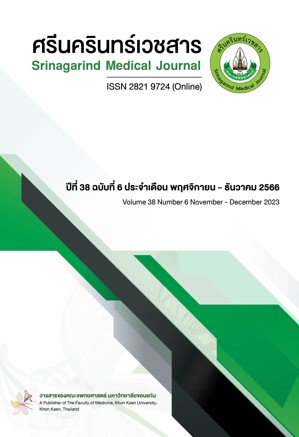ผลของการให้สารน้ำปริมาณมากเทียบกับปริมาณน้อยในห้องฉุกเฉินต่อการเสียชีวิตในผู้ป่วยที่มีภาวะพิษเหตุติดเชื้อ
คำสำคัญ:
ช็อคพิษเหตุติดเชื้อ, พิษเหตุติดเชื้อที่มีภาวะเนื้อเยื่อขาดออกซิเจน, การให้สารน้ำ, ห้องฉุกเฉิน, การเสียชีวิตบทคัดย่อ
หลักการและวัตถุประสงค์: การให้สารน้ำเป็นการรักษาที่สำคัญในการรักษาผู้ป่วยที่มีภาวะพิษเหตุติดเชื้อ ตามคำแนะนำของแนวทางการรักษาผู้ป่วยพิษเหตุติดเชื้อได้แนะนำให้สารน้ำอย่างน้อย 30 มิลลิลิตรต่อกิโลกรัมในสามชั่วโมงแรกในการรักษาผู้ป่วยกลุ่มดังกล่าว อย่างไรก็ตามคำแนะนำดังกล่าวไม่มีหลักฐานสนับสนุนที่ชัดเจนว่าช่วยลดการเสียชีวิตในผู้ป่วยพิษเหตุติดเชื้อ วัตถุประสงค์ของการศึกษานี้จึงต้องการศึกษาผลของการให้สารน้ำปริมาณดังกล่าวขณะผู้ป่วยเข้ารับการรักษาในห้องฉุกเฉินและการเสียชีวิตในโรงพยาบาล
วิธีการศึกษา: เป็นการศึกษาเชิงพรรณนาโดยการเก็บข้อมูลแบบย้อนหลังในผู้ป่วยที่มีภาวะพิษเหตุติดเชื้อที่มีภาวะเนื้อเยื่อขาดออกซิเจน หรือมีภาวะช็อคที่เข้ารับการรักษาในห้องฉุกเฉิน โดยแบ่งผู้ป่วยเป็นกลุ่มที่ได้รับสารน้ำปริมาณมาก (≥30 มิลลิลิตรต่อกิโลกรัม) และกลุ่มที่ได้รับสารน้ำปริมาณน้อย (<30 มิลลิลิตรต่อกิโลกรัม) ขณะที่รักษาในห้องฉุกเฉิน โดยผลลัพธ์หลักของการศึกษาคือการเสียชีวิตในโรงพยาบาลโดยทำการวิเคราะห์การถดถอยโลจีสติกแบบหลายตัวแปรและกราฟแคพแพล-ไมเยอร์
ผลการศึกษา: มีผู้ป่วยในการศึกษาทั้งสิ้น 355 ราย โดยแบ่งเป็นกลุ่มได้รับสารน้ำปริมาณมาก 159 ราย และได้รับสารน้ำปริมาณน้อย 196 ราย ผู้ป่วย 39 รายในกลุ่มที่ได้รับสารน้ำปริมาณมาก และ 60 รายในกลุ่มที่ได้รับสารน้ำปริมาณน้อยเสียชีวิตในโรงพยาบาล จากการวิเคราะห์โดยการถดถอยโลจีสติกไม่พบความสัมพันธ์ของการได้รับสารน้ำปริมาณมากต่อการลดการเสียชีวิตของผู้ป่วยพิษเหตุติดเชื้อที่มีอาการหรืออาการแสดงของภาวะเนื้อเยื่อขาดออกซิเจน หรือมีภาวะช็อค AOR 0.59 (0.35-1.02) p= 0.056
สรุป: ในผู้ป่วยพิษเหตุติดเชื้อที่มีอาการหรืออาการแสดงของภาวะเนื้อเยื่อขาดออกซิเจน หรือมีภาวะช็อค การให้สารน้ำปริมาณมากไม่สัมพันธ์กับการลดการเสียชีวิต
เอกสารอ้างอิง
Evans L, Rhodes A, Alhazzani W, Antonelli M, Coopersmith CM, French C, et al. Surviving sepsis campaign: international guidelines for management of sepsis and septic shock 2021. Intensive Care Med 2021;47(11):1181-247. doi:10.1007/s00134-021-06506-y.
Levy MM, Evans LE, Rhodes A. The surviving sepsis campaign bundle: 2018 update. Intensive Care Med 2018;44(6):925-8. doi:10.1007/s00134-018-5085-0
ProCESS Investigators; Yealy DM, Kellum JA, Huang DT, Barnato AE, Weissfeld LA, Pike F, et al. A randomized trial of protocol-based care for early septic shock. N Engl J Med 2014;370(18):1683-93. doi:10.1056/NEJMoa1401602.
ARISE Investigators; ANZICS Clinical Trials Group; Peake SL, Delaney A, Bailey M, Bellomo R, Cameron PA, Cooper DJ, et al. Goal-directed resuscitation for patients with early septic shock. N Engl J Med 2014;371(16):1496-506. doi:10.1056/NEJMoa1404380.
Mouncey PR, Osborn TM, Power GS, Harrison DA, Sadique MZ, Grieve RD, et al. ProMISe Trial Investigators. Trial of early, goal-directed resuscitation for septic shock. N Engl J Med 2015;372(14):1301-11. doi:10.1056/NEJMoa1500896.
Acharya R, Patel A, Schultz E, Bourgeois M, Kandinata N, Paswan R, et al. Fluid resuscitation and outcomes in heart failure patients with severe sepsis or septic shock: a retrospective case-control study. PLoS One 2021;16(8):e0256368. doi:10.1371/journal.pone.0256368.
Matsuda W, Funato Y, Miyazaki M, Tomiyama K. Fluid resuscitation of at least 30 ml/kg was not associated with decreased mortality in patients with infection, signs of hypoperfusion, and a do-not-intubate order. Acute Med Surg 2022;9(1):e795. doi:10.1002/ams2.795.
Wang HL, Shao J, Liu WL, Wu F, Chen HB, Zheng RQ, et al. Initial fluid resuscitation (30 ml/kg) in patients with septic shock: more or less? Am J Emerg Med 2021;50:309-15. doi:10.1016/j.ajem.2021.08.016.
Lee SJ, Ramar K, Park JG, Gajic O, Li G, Kashyap R. Increased fluid administration in the first three hours of sepsis resuscitation is associated with reduced mortality: a retrospective cohort study. Chest 2014;146(4):908-15. doi:10.1378/chest.13-2702.
Hu B, Chen JCY, Dong Y, Frank RD, Passe M, Portner E, et al. Effect of initial infusion rates of fluid resuscitation on outcomes in patients with septic shock: a historical cohort study. Crit Care 2020;24(1):137. doi:10.1186/s13054-020-2819-5.
Singer M, Deutschman CS, Seymour CW, Shankar-Hari M, Annane D, Bauer M, et al. The third international consensus definitions for sepsis and septic shock (Sepsis-3). JAMA 2016;315(8):801-10. doi:10.1001/jama.2016.0287.
Al Aseri Z. Assessment and management of hypoperfusion in sepsis and septic shock [Internet]. Infections and Sepsis Development. IntechOpen; 2021. [cited 5 May 2023]. Available from: http://dx.doi.org/10.5772/intechopen.98876
Jones AE, Puskarich MA. Sepsis-induced tissue hypoperfusion. Crit Care Clin 2009;25(4):769-79, ix. doi:10.1016/j.ccc.2009.06.003.
Bernard, R. Fundamentals of biostatistics. 5thed. Duxbery: Thomson learning; 2000.
Semler MW, Rice TW. Sepsis resuscitation: fluid choice and dose. Clin Chest Med 2016;37(2):241-50. doi:10.1016/j.ccm.2016.01.007.
Angus DC, van der Poll T. Severe sepsis and septic shock. N Engl J Med 2013;369(9):840-51. doi:10.1056/NEJMra1208623.
Yohannes S, Serafim LP, Slavinsky V, O'Connor T, Cabrera M, Chin MK, et al. Evaluation of the recommended 30 cc/kg fluid dose for patients with septic shock and hypoperfusion with lactate greater than 4 mmol/L. Crit Care Explor 2023;5(7):e0932. doi:10.1097/CCE.0000000000000932.
Acheampong A, Vincent JL. A positive fluid balance is an independent prognostic factor in patients with sepsis. Crit Care 2015;19(1):251. doi:10.1186/s13054-015-0970-1.
Zheng R, Jin X, Liao W, Lin L. Association between the volume of fluid resuscitation and mortality modified by disease severity in patients with sepsis in ICU: a retrospective cohort study. BMJ Open 2023;13(4):e066056. doi:10.1136/bmjopen-2022-066056.
Permpikul C, Tongyoo S, Viarasilpa T, Trainarongsakul T, Chakorn T, Udompanturak S. Early use of norepinephrine in septic shock resuscitation (CENSER). A randomized trial. Am J Respir Crit Care Med 2019;199(9):1097-105. doi:10.1164/rccm.201806-1034OC.
Monnet X, Lai C, Teboul JL. How I personalize fluid therapy in septic shock? Crit Care 2023;27(1):123. doi:10.1186/s13054-023-04363-3.
Moschopoulos CD, Dimopoulou D, Dimopoulou A, Dimopoulou K, Protopapas K, Zavras N, et al. New insights into the fluid management in patients with septic shock. Medicina (Kaunas) 2023;59(6):1047. doi:10.3390/medicina59061047.
ดาวน์โหลด
เผยแพร่แล้ว
รูปแบบการอ้างอิง
ฉบับ
ประเภทบทความ
สัญญาอนุญาต
ลิขสิทธิ์ (c) 2023 ศรีนครินทร์เวชสาร

อนุญาตภายใต้เงื่อนไข Creative Commons Attribution-NonCommercial-NoDerivatives 4.0 International License.




